Tour Outline (abbreviated): (Mouseover/out pictures to toggle size) In this walking tour we will show you a small portion of all Buenos Aires can offer: its originary neighbourhoods and history. Once you are familiar with these areas you will be able to access hundreds of interesting and fun places and activities on your own and without any help.
Early Buenos Aires

How big is this city?
How many people live in it?
When was it founded and how many times? Why?
What was its original name?
Why is this country called Argentina?
Who were the original inhabitants?
What makes this country different?
Originally "Ciudad de la Santisima Trinidad y Puerto de Nuestra Señora del Bonaire", Buenos Aires is a large city: it covers 200 square kilometers with a population of 4.5 million people within the ring road and 10M more in the suburbs.
It was founded twice: the first time in 1536 (by Pedro de Mendoza) and next in 1580 (by Juan de Garay). Pedro de Mendoza was a wealthy nobleman whose mother convinced the kings of Spain that her son was the right person to conquer the Southern tip of South America on the King's behalf. He was authorized to be the administrator/manager of all the land he could grab and also to keep 90% of whatever ransom he could get for any chiefs he could kidnap/imprison. Pedro Mendoza heard from Hernan Cortez and Francisco Pizarro that 'mountains of silver' (literally) could be found down here and that is why the country is called Argentina (Argentum means silver in Latin). Once he arrived with 15 ships and 1200 crew-members, he was welcome by the Indians (Querandies) who shared with them their food and resources.
But the Spanish took the Indians for granted since the Spanish thought they had the God-given right to seize whatever they wanted. After some time, the Indians began feeling abused and stopped serving the Spanish and the Spanish got angry and mean and decided they would punish the Indians, which basically caused the Querandies to react, and in the fights that followed along four and a half years, the Indians sieged the Spanish fort and killed almost all the Spanish. About 30 ultimately made it back to Spain. Thus the Spanish abandoned the area but 40 years later they started worrying the Portugese would expand from Brazil and capture these territories, so they sent a new expedition, this time led by Juan de Garay, who founded BA again in 1580.
(top...)
Avenida 9 de Julio
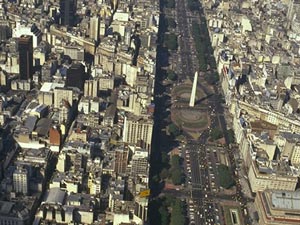
How wide is this avenue?
When was it built and why?
How old is it, and what was it originally?
When did it adopt its current format?
Avenida 9 de Julio: They say it is the widest avenue in the world. The distance between adjacent streets is roughly 110 m (or 140 when you add its two side roads). It was built in the dawn of automobile boom: inaugurated on 9 July 1937. At that time it was only 5 blocks long. Later enhanced in the 1960s and 1980s with obvious complaints from people whose land was expropriated.
Under normal walking speed, it takes pedestrians two to three green lights to cross it, even longer for the elderly. Since 2014 we have had the Metrobus (central lanes only for buses) speedy transport. The national government tried to accuse the city government for destroying the Jacaranda trees that were there (explain Natl. Govt. versus City Govt.)
(top...)
Obelisco
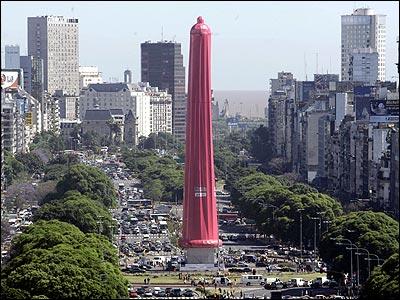
How tall is it?
What is inside it?
What was it built for?
What was here before?
Has it ever been used for other purposes?
The Obelisk stands where the San Nicolás de Bari chapel (1727) stood. From one of its towers, the national flag waved for the first time in the city. The church was demolished in order to widen the Avenida Corrientes and the 9 de Julio. The Obelisk also commemorates the two foundings of Buenos Aires. Today it is used as a meeting point for the masses: both demonstrations of any kind (football -not soccer- wins are also celebrated here: we explain the deep British roots of Argentina -now politically incorrect- in our Morning Walk) and public concerts take place here.
It is bare concrete, although later was clad in stone that soon after started to fall and had to be removed completely for safety reasons. The style is purely rationalist, very much in tune with the changing architecture of the time. The Obelisk was built in 1936 by Siemens in just 60 days (!) to mark the spot where the national flag of Argentina was raised for the first time ever in our city. The flag was used for the first time in Rosario (500 km away). It has no other functionality since it's not open to the public to climb (no elevator, no stairwell, only one vertical ladder with 206 rungs and 6 recesses). In 2005 the city decided to dress the Obelisk for AIDS Awareness Week with a 72m. pink vinyl condom.
(top...)
Plaza Lavalle
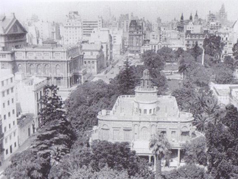
What was here before?
What did the British built here?
Where there any fights fought here?
Originally a small swampy lake, in 1822 the government placed an armory here, conveniently located in the periphery of the city. A few years later, a group of English businessmen purchased the surrounding land and created a public garden and called it Vauxhall, like the London park south of the Themes, to satisfy the increasingly bourgeois British society.
Besides, this park did not reach the success of the English counterpart and the small popularity it had had soon declined. By 1878, the park was given its current name and new landscaping transformed the area into a fashionable meeting point. Most of the trees planted still stand today. Twelve years later the park became the scene of a bloody revolt between radicals and the opposing government.
(top...)
Statue of Norma Fontenla & José Neglia
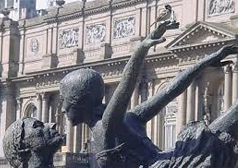
Who are these people?
What were they famous for?
What happened to them?
This sculptures commemorates two very talented Argentinian dancers who achieved interneational fame and danced with Margot Fonteyn and Rudolph Nureyev.
They both died in an airplane accident in 1971.
(top...)
Escuela Roca
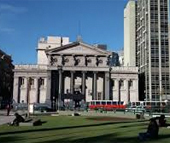
What is special about this school?
What is special about this building?
Who built it and why?
In 1884, new laws established free and secular education for all children through the primary level. That was the origin of a program to build a considerable number of schools. Among them were the Escuela Roca and the Escuela Avellaneda, each standing at either side of the Plaza Lavalle.
The Escuela Roca is a project of the turn of the century, when the Italian Carlo Morra designed a project including hygienic, infrastructural and functional improvements. It was an avant garde way of seeing educational institutions, at the time, where all classrooms, patios, offices, and ceremony halls were built to facilitate the dynamism required by education. The austere façade is completed with a visually engaging portico resembling a 'temple for education'.
(top...)
Teatro Colon (Columbus) Opera House
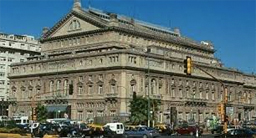
Where was this theatre first built?
What was in this site before the theatre was built?
How many architects werein charge of its design and what happedned to them?
Who paid for this and how?
How many people will it hold?
Would it allow for all kind of customers?
Were there ever any animals performing here?
What is special about its acoustics?
Can it be visited without joining a performance?
The Colon was first built just across from the president’s (Pink) House, but it caught fire and was rebuilt here where the first railroad, 'La Porteña' had its terminal station.
Back then it was visited by Italian companies touring the main cities of South America. It is important to realize that in the early 1900's Buenos Aires was the most important city in South America (as explained and demonstrated in our Morning Walk) taking great influence from the French and English Europeans, in costumes, fashion, readings, architecture and music. It took four years took to approve the first architect’s plans. His name was Francesco Tamburini.
The initial financing came from selling the remains of the original building. The process had many shortcomings, and the country’s financial crisis delayed construction. Over 40 aristocratic families made donations on the condition of having “preferential” seating which caused the architects to reconsider the original drawings, so as to add more balconies and seats. When the original designer, Arch. Tambourini died, a new architect. Vittorio Meano (and Italian who also built the Congress building) took over. Donors complained about the boring design so Meano got rid of all the “German severity”, giving the building a more cheerful and Italian appeal.
Meano was a womanizer and was murdered by his ex-valet who had been having an affair with his wife (mention Arch. Rattenbury if there are any Canadians or Brits). So a third architect (is this true?) Arch. Jules Dormant took over and modified the style again with a more 'French' finishing (Italian style was not in vogue for upper classes in BA at this time). The inauguration took place on May 25, 1908 (independence day) with a showing of Aída by Verdi with live animals and horses on stage! Teatro Colón became the stop for every reputable lyric company and many European artists continued working here even when there was a war going on in Europe. It recently underwent a massive renovation that literally brought it back to its original splendor. The theatre can seat over 3500 spectators and its acoustics are rated among the best in the world. It has school of dance, lyric singing, acting and a museum. Guided daily tours are available there.
(top...)
Young Gomero Tree
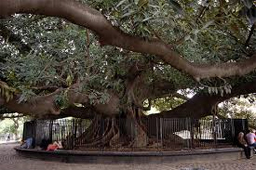
What kind of tree is this?
How large can it grow?
Are there any much larger trees like this in town?
Where can they be found and how old are they?
Ficus macrophylla, commonly known as the Moreton Bay fig, is a large evergreen banyan tree of the Moraceae family that is a native of most of the eastern coast of Australia. Its common name is derived from Moreton Bay in Queensland, Australia. It is best known for its beautiful buttress roots.
As Ficus macrophylla is a strangler fig, seed germination usually takes place in the canopy of a host tree and the seedling lives as an epiphyte until its roots establish contact with the ground. It then enlarges and strangles its host, eventually becoming a freestanding tree by itself.
Individuals may reach 60 m (200 ft) in height. Like all figs, it has an obligate mutualism with fig wasps; figs are only pollinated by fig wasps, and fig wasps can only reproduce in fig flowers.
Ficus macrophylla is widely used as a feature tree in public parks and gardens in warmer climates. Old specimens can reach tremendous size. Its aggressive root system allows its use in only the largest private gardens. See **much** larger ones along our 'Best of BA' and 'Recoleta' Walks!
(top...)
Main Synagogue
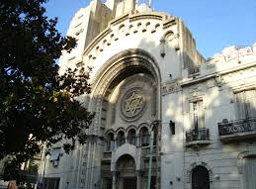
How many jews in Argentina?
When did they first arrive?
Have there been any large attacks to the Jewish community here?
What do the symbols in the facade mean?
What can you find inside this building?
First Jewish immigrants arrived about the mid 19th century, mainly from Germany, England, and France. Later they also came from Poland and Rusia. Soon after getting here, they found out there weren’t any official laws allowing marriages other than weddings in Catholic Churches, and they were therefore not able to marry.
These immigrants created institutions that represented their own creeds. This temple’s design is inspired by the mid nineteenth century German temples, with Romanic and byzantine influences. The façade includes the Star of David, the tablets of the Ten Commandments and two hands representing a blessing of priests in old Jerusalem (mention Dr. Spock of Startrek fame) and there are twelve medallions on the entrance gate representing the twelve tribes of Israel. Construction started in 1897 and finished 35 years later in 1932. Next to the Synagogue is the Jewish Museum "Dr. Salvador Kibrick".
(top...)
Teatro Cervantes
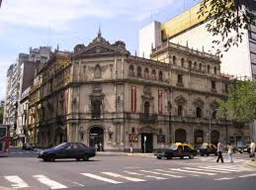
Who is this theatre named after, and why?
Who paid for it?
What is the large modern building beside it? Why was it built?
How were materials for this building collected? From where? How did they get here?
How important is this building and why?
Don Miguel de Cervantes was the author of arguably the most important book in all of Spanish literature: El Quixote of La Mancha. This theatre was named after him. It was the brainchild of María Guerrero and Fernando Díaz de Mendoza, two very respected Spanish actors from the early twentieth century. It offers a strong revival of and resemblance to the Colonial and Spanish styles (we fought the Spanish to become independent, but after the visit of the Infanta in 1910, “we were friends again”) .
Designed by the pair of architects Fernando Aranda and Emilio Repetto, the building was inspired by the Rectory of the Universidad de Alcalá de Henares, in Spain. The King of Spain at the time, Alfonso XIII, was a cheerful advocates of the project, ordering all Spanish ships to transport construction supplies for the Theatre. It has amazing architecture inside, and it is richly adorned with tapestry and curtains from Madrid and beautifully carved seats, the mirrors and iron fittings from Seville. Other objects were brought from Barcelona. The theater was destined to be the great platform for Spanish dramaturgy.
It had though, very bad management and five years later, in 1926, it declared bankruptcy and was bought by the Argentinean government. In 1961, fire destroyed most of the stage and dressing rooms, and it reopened in 1986 with amazing annexes (the modern adjacent highrise building disguises a huge elavator with "liftable" stages). by In 1995 it became officially a "National Treasure".
(top...)
Feuds on Plaza Lavalle

Why is the amazing Miro Palace that stood here gone?
What did this family do to the southern facing windows and why?
How does this relate to the Column Monument a block away?
Who sought refuge in this building and why?
At the north end of the park stood a beautiful mansion ('Palacio Miro') owned by descendants of Coronel Dorrego, one of the first governors, executed without trial by General Lavalle. Dorrego was a good man, a good father and a good husband and wrote beautiful goodby letters to the family before being executed. Feisty Lieutenant Juan Lavalle had him summarily executed without a trial just to clear the way for his boss--who took over and thus considered him a hero.
In 1878 a monument (column) was built at the Tucuman street crossing, to honor General Lavalle. This was utterly offensive for the descendants of the Dorrego family, who decided they would fence closed all south-oriented windows that over-looked the monument of their family's slayer.
Later, in 1890 the "Revolución del Parque" lasted for three days and took 300 lives.
(top...)
Music Stands

What is this about?
Which famous people is it related to?
The Music Stands is an art installation built for the bicentennial of the country's independence in 2010.
Named Full Orchestra ()'A toda orquesta II') by Carlos Gallardo pays hommage to Teatro Colón and all Artists for the Bicentennial celebration.
It also pays hommage to our most representative musicians: Carlos Gardel--the unforgettable first Tango crooner (of whom we say 'he sings better each day' ('Gardel cada dia canta mejor') as time goes by--though he died in an airplane crash in 1936), Astor Piazzola--who turned Tango into Classical status (like George Gershwin did with Jazz), Argentine born pianist and Director Daniel Barenboim, and many others.
It symbolizes the dialog between a 'virtual orchestra' and nature.
(top...)
Palacio Costaguta / Torre Massue

Who built this and why?
What is special about it?
Who owned this building?
One block away we find one of the few remaining examples of Art Nouveau of in the city. This is the Palacio Costaguta better known as Mirador Massue. This style was hard to find in the houses of the traditional families because they favored the academicism made popular a few decades earlier.
Besides, the new wealthy, usually immigrants who knew how to use the advantages of this prosperous city, welcomed the suggestions of the new architectural ideas of the time. This house was actually two properties disguised behind a single façade. The ground floor was designated for shops and the three upper floors for residences.
The owner was an Italian businessman, who ordered the project from Alfred Massue, a French architect who lived in Buenos Aires for about 25 years before later returning and dying in Barcelona. He built several buildings in BA but sadly very few stand still today.
(top...)
Law Courts
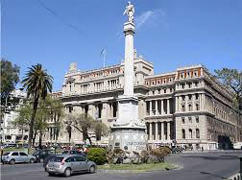
What is this building for?
How long did it take to build?
What are the symbols that decorate it?
What is law like in Argentina?
How is it different?
The Palacio de Tribunales (Court House) is another testament to the expansion of the city during the first three decades of the last century. The building replaced the old Artillery Factory (armory), which had to be removed once the neighborhood became more populated. The construction started in 1904 although they didn’t resume until four years later. The architect Norbert Maillart took responsibility for the project and he completed a portion of the building by 1910, for the celebration of the 100th anniversary of the Revolution.
Two years later Maillart was fired and the municipal Architectural Direction took charge. That is why the building was not finished until 1942. They are many criticisms of this building including the proportions, the pointless stairwells, and a few aimless corridors. The façade is a typical example of the eclecticism of the turn of the century where academic influence mixes with Greco-Roman fixtures. Of special note are the Egyptian inscriptions, the National insignia, the Scale representing Justice & the Ten Commandments.
(top...)
Libertad Street
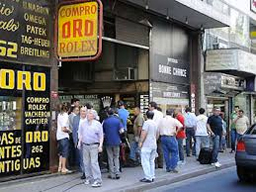
What is special about this street?
What is the way people here do trade?
How many thousand people work here?
Nueva York has its Diamond District: (47th & 5th). Bogotá, the Emerald Trade Center and the 'Parque de los Esmeralderos', where jewels are sold on the curb. In Buenos Aires, for over 100 years it has been Calle Libertad.
In this small shops (many more hidden upstairs--only accesible by referral) heirs of 2nd and 3d generation jewellers say their guild start operating here in the year 1900. It was the time of chain-watches and they were built, sold and repaired here.
Some jewellers would go selling door to door at the many city neighborhoods and get paid in instqallments they would themselves collect.
In these few blocks there are over 4000 jewellers. And even today, it is an important alternative job for older unemployable women and men who will sell house-to house on referral.
Wholesalers can be found in the first three blocks and retailers in the next two.
Jewellry is one of the main means of saving, investing and smuggling, as jewells can often be carried as personal goods.
(top...)
Masoneria Argentina

What is Masonry, who are the Freemasons?
How are they related to the DaVinci Code?
Which of all founders of Independence in the Americas were Freemason?
Who orchestrated the independence of all American countries and why?
How do different churches & religions see Freemasons?
Is Masonry still important?
Freemasonry in Buenos Aires started with the consecration of a lodge (“Logia Independencia”) in 1795 consisting of young intellectuals mostly with advanced university degrees from Europe. Among the most prominent members were Juan José Castelli, his cousin Manuel Belgrano, Juan José Paso, Nicolás Rodríguez Peña, Juan Larrea, and Antonio Berutti.
Going forward in time and leading up to May 25, 1808 Don José de San Martín joined his first lodge, the “Logia Integridad” and got initiated in Cadiz. San Martin. He was only a junior Mason at the time when he met his fraternal brother Lord Mac Duff , a noble Scotsman, who was plotting the liberation of South America.
It is interesting to note that the First governments in Argentina were mostly formed by Masons.
Freemasonry is a society of men concerned with moral and spiritual values. Its members are taught its precepts (moral lessons and self-knowledge) by a series of ritual dramas — a progression of allegorical two-part plays which are learnt by heart and performed within each Lodge — which follow ancient forms, and use stonemasons’ customs and tools as allegorical guides.
Freemasonry instills in its members a moral and ethical approach to life: it seeks to reinforce thoughtfulness for others, kindness in the community, honesty in business, courtesy in society and fairness in all things. Members are urged to regard the interests of the family as paramount but, importantly, Freemasonry also teaches and practices concern for people, care for the less fortunate and help for those in need.
(top...)
Talcahuano Music Stores
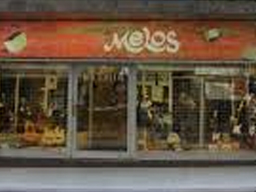
Why do music stores pile-up here?
When did this start?
What is happening to Argentine music?
With a story somewhat similar to Libertad Street Jewellers, many other guilds and activities in Buenos Aires 'flock' along downtown streets for convenience and business.
Corrientes Av. has a large concentration of Theatres (mostly comedic). Theatres here often have shows till the wee hours: late movies or plays usua;y start 1:30am on weekends (Fridays & Saturdays). Also Corrientes Av. is famous for its bookstores which often close as late as theatres.
Talcahuano Street has developed since 1970 into the music store paradise, where thousands of musical instruments and its electronic aids can be bought, sold or repaired.
Nearby (parallel) Uruguay street is a favorite for electronic components (transistors, chips, transformers, etc.).
Parana street (next, going west) is the one for plastics (PVC, plexiglass, tubing, etc.) no only for raw materials but they will build for you anything you design.
(top...)
Pasaje Rivarola
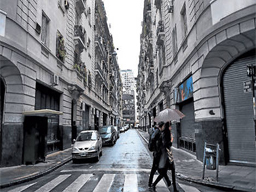
Why was this architecture implemented?
What did it try to achieve?
What is special about it?
Mirror-like symmetry! At htis time, young Buenos Aires was experimenting with architecture from all over theworld.
In this street an attempt for perfect European symmetry was implemented. All buildings were exactly similar to the one across the street. Like in a mirror.
These were luxury buildings, with marble floors and facades and oak wooden floors.
Inside each appartment, brass doors, doorframes and doorknobs and fraught iron railings.
Each corner building has an elegant tower and dome on top.
(top...)
Iglesia & pasaje La Piedad

Who built this church and why?
What are the main Religions in Argentina?
How many major catholic churches (basilicas) in Argentina?
Why was this architecture implemented?
What did it try to achieve?
What is special about it?
These neoclasssic church was buit (again) by famous architect Juan Antonio Busquiazzo (22 de noviembre de 1895).
it has two steeples and a frontis showing Jesus being uncrucified (thus the name of 'Piedad'--pity).
The charm of this old city area is enhanced by the opposite 'Pasaje de la Piedad'. It is U-shaped and combines both Frenchand Italian architectures in a most charming way and is often preferred home for artists: sculptors & painters
It holds approximately 114 homes as an attempt to build a 'street inside a city block'. Inside there are 49 inside-street-facing houses. On the outside (street) many houses have storefronts for owners to live and work-from-home.
(top...)
Confiteria el Molino
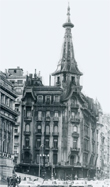
Why was this architecture implemented?
What did it try to achieve?
What happened to this building?
What made it famous?
How does it relate to Madonna Ceccone (the famous American singer)
A valuable show of art-noveu and Belle Époque, it used to be a 'must-meet-there' for all congressmen and wealthy families.
High above, it had a real turning wind-mill, thus its name. Most of the walls were decorated with tigerseye tiles which reflected the light.
Arch. Gianotti had all tiles, vitraux, marbles, windows, doors, ceramics and even the doorknobs from Italy.
With its gray marble floors and brown marble walls, For over 100 years they served delicios teas, pastries and thin bread sandwiches in 'triolets' (multi storied trays) that made it famous, on small round, marble tables with Thonet (wood and wicker)
It opened on centennial independence day (9 July, 1916) and was closed down in 1997.
Popular italian-american singer Madonna Ceccone filmed a clip for her hit song «Love Don't Live Here Anymore» here on March 7, 1996, While she was staying in town to shoot parts of her movie about Evita (Peron).
(top...)
Congreso
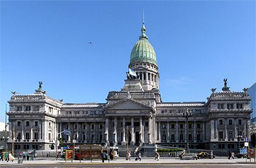
Who built this colossal building and who murdered him? Why?
In what way this story relates to the magnificent parliament in Victoria, BC, Canada?
Who completed it and when?
What are the symbols and statues on it? Who made them?
Who was Lola Mora? What made her famous?
How does Argentina's government work? How is Governement composed?
What is (in a nutshell) the brief story of Argentina's governements?
From here we can see the imposing silhouette of the National Congress Palace. Designed by the Italian architect Vittorio Meano and completed by Argentine architect Julio Dormal, this neoclassical building was under construction between 1898 and 1906. Inaugurated that year, its aesthetic details were not completed until 1946.
The quadriga (horses pulling a war cart) atop the entrance is the work of sculptor Victor de Pol; Argentine sculptor Lola Mora graced the interior halls and exterior alike with numerous allegorical bronzes and marble statues, including those in the facade.
It is ineteresting to note that Architect Meano was murdered by his wife's lover, just as English-Canadian Architecht Francis Mawson Rattenbury, builder of the beautiful Parliament Building in British Columbia was!! Watch out workaholic architects with your unattended wives!
(top...)
Plaza Congreso
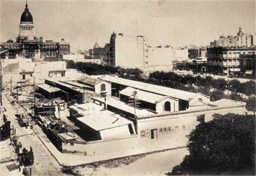
What are the monuments in this park?
What do they mean?
What is the story with its fences?
Does anyone 'camp' here? How often? Why?
Facing Congress, Congressional Plaza (park) was designed by French architect Charles Thays, and is dominated by the Monument to the Two Congresses, the work of Belgian sculptor Jules Lagae set on a Neoclassical esplanade designed by his fellow countryman, architect Henri d'Huicque, and completed in 1914. It was named in honor of the Constitutional Assembly of 1813, the first local attempt to create national law, and the Congress of Tucumán of 1816, which declared Independence from the Spanish Empire, and many locals refer to the plaza by that name.
The monument's centerpiece, the Allegory of the Republic, and the remaining bronze allegories are set entirely in stone from Nancy, France. The monument is also known for its adjoining terraced fountain and its bronze Neptunes.
The monument celebrates the centennial of the 1816 declaration of independence. The central figure represents the Republic on the march, with snake faces and an allegory of abundance at its feet. The two lateral figures represent the assembly of 1813 and the congress of 1816. There are also other representations of national fauna, notably of horses and condors.
(top...)
Mile Zero, Buenos Aires

How big is Argentina?
How long?
How wide?
How many miles of railroads? Who built them?
How many major cities?
How many provinces?
What is the name of the longest highway and where does it go?
Argentina marks its 'kilometer zero' (mile zero) with a monolith in this park. The work of the brothers Máximo and José Fioravanti, the structure was placed on the north side of Plaza Lorea on October 2, 1935; it was moved to its present location on May 18, 1944.
An image of Our Lady of Luján (honored on the monolith as 'the patron saint of the national road network') appears on the monolith's north face, a relief map of Argentina is on the south face, plaques in honor of José de San Martín are west, and on its eastern side, the date of the decree and the name of the relevant authorities.
The 'Virgen de Lujan' became a revered symbol because when this small statue was being carried in a box towards the city, the oxen stopped and would walk no more when they passed by a ranch at the small town of Lujan. The oxen would only walk once the little box with the statue was unloaded, thus everyone interpreted it was a miracle she caused because she 'wanted to stay' in that spot of the road.
(top...)
Monument to Mariano Moreno
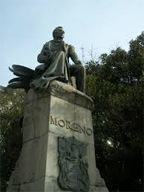
Who was Moreno and what did he do?
How did he die?
Where?
Mariano Moreno (1778 – 1811) was a lawyer, journalist and politician who played a decisive role in the May Revolution which led to the declaration of independence of Argentina from Spain. Mariano Moreno Plaza, to the east, is separated from Congressional Plaza (proper) by Montevideo Avenue, and was named in honor of Mariano Moreno, the intellectual leader of the 1810 May Revolution that led to Independence. A monument in his honor was unveiled in 1910.
He was killed by poisoning by his enemies at sea on his way to England.
Moreno Plaza is best known to many as the site of one of the few surviving original casts of Auguste Rodin's The Thinker sculpture. Commissioned by Museum’s Director Eduardo Schiaffino for the city in 1907, he and Rodin had envisioned its placement on a pedestal on the grand steps in front of Congress
(top...)
Plaza Lorea

What was here before?
Who is it named after?
Why did she die? Fighting agains whom?
Where the old Fire hall stood, the plaza itself is dominated by the monument to José Manuel Estrada, a leading Catholic intellectual and politician in Buenos Aires in the second half of the 19th century, known for his opposition to secular education during the late 19th century.
The grounds of this square were owned by the Spanish merchant Isidro Lorea, who with his wife died in this place in 1807 fending off the British troops during the British invasions of Buenos Aires and the Río de la Plata.
(top...)
Instituto Biológico Argentino
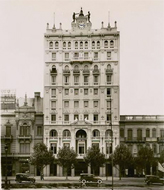
What is special about this building? What does it copy?
How are the clock and bells activated?
The (ex) Instituto Biológico Argentino Clock Building (and ex 'Caja Nacional de Previsión Social--Social Wellfare) on Av. Rivadavia 1746 is a remarkable 10 story building with a beautiful clock on top.
This clock is composed of a large dial and two large bronze statues which action a loud 4 ton silver-copper alloy set of bells.
It is activated by a special mechanism that lowers a 500kg counterweight along a special well along th3e whole building, all the way to the cellar.
This device was built in Turin, Italy and was inspired in the tower clock built in Venice in 1496.
(top...)
The Thinker
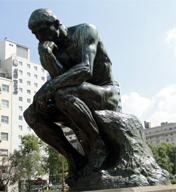
What does this represent?
Who sculpted it?
Why do we have many of his works in Argentina?
How many originals are there of this work?
What is the sculptor's secret to achieve dramatism?
The Thinker (French: Le Penseur) is a bronze sculpture by Auguste Rodin, usually placed on a stone pedestal. The work shows a nude male figure of over life-size sitting on a rock with his chin resting on one hand as though deep in thought, and is often used as an image to represent philosophy.
There are about 28 full size castings, in which the figure is about 186 centimetres (73 in) high, though not all were made during Rodin's lifetime and under his supervision, as well as various other versions, several in plaster, studies, and posthumous castings, in a range of sizes. Rodin first conceived the figure as part of another work in 1880, but the first of the familiar monumental bronze castings did not appear until 1904.
(top...)
Av de Mayo

Why was Av. de Mayo built and when?
What does it copy?
Which important Argentine institutions does it link and how?
For which national events is the avenue used?
Which immigrant community did it house?
In which way would this immigrants relate during wars in their country?
Built on an initiative by Mayor Torcuato de Alvear, work began in 1885 and was completed in 1894. The avenue is often compared with La Gran Vía in Madrid, although the Spanish avenue was built later (1910). It is also compared to those in Paris or Barcelona due to its sophisticated buildings of art nouveau, neoclassic and eclectic styles. The avenue was named in honor of the May Revolution of 1810 (the event that led to Argentine Independence).
The site of the assembly that touched off the revolution (the Buenos Aires Cabildo) was partially demolished in 1888 to make way for the avenue's entry into Plaza de Mayo, ironically. The avenue's layout, built through existing urban blocks instead of via the widening of a parallel street, was designed by the Municipal public Works Director, Juan Antonio Buschiazzo. Buschiazzo was also commissioned to design a number of the buildings along the avenue (among them, City Hall) after Mayor Miguel Cané enacted strict architectural zoning laws for the area facing the new thoroughfare. The recession caused by the Panic of 1890 led to delays and a rollback of many of the more ornate plans for the avenue, which was inaugurated on July 9, 1894 (the 78th anniversary of Independence).
Mayor Cané's strict regulations initially governed architecture along the 30 m (99 ft)-wide avenue, which limited the height of real estate facing it to 24 m (79 ft). The Barolo Tower was the first to be granted an exception to this and since then, numerous office buildings have been built in excess of these stipulations (though they remain largely an exception). The Avenida de Mayo was the site of the first Buenos Aires Metro stations; opened in 1913, these were the first outside the United States or Europe. The avenue itself underwent its only significant alteration in 1937, when two blocks were demolished to make way for the perpendicular Avenida 9 de Julio (then the widest in the world). Seeking to halt future demolitions along the avenue, Decree 437/97 of the National Executive Branch declared the Avenue a National Historic Site in 1997 and, as a result, the aesthetics of the buildings, billboards, and marquees could not be changed.
(top...)
La Inmobiliaria building
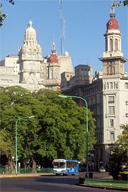
Who owned this building? What was it for?
Why was this architecture modified?
What does it demonstrate?
In this corner we find the La Inmobiliaria building, built at the down of the Centennial celebrations, encloses in a monumental fashion a collection of shops, bars and apartments. It was once refuge for writers and journalists, expending evenings of debate.
Edificio La Inmobiliaria occupies the whole block of Avenida de Mayo 1400 and has many entrances along it, plus entrances through the side streets.
Poorly restored in 1968 (one of our many Military dictatorship times) its colorful slate covering was destroyed. In 1993 a beter restoration improved (just a bit) its look once again.
It boasts greek-god statue-pairs (Venus & Apollo) and 'loggias' arched galleries with pedestals and half-point arches typical of italian architecture, decorated with paintings which are currently highly deteriorated, including the name of the company that owned the building in policromed mosaic and reads: 'La Inmobiliaria'.
(top...)
Diario Crítica
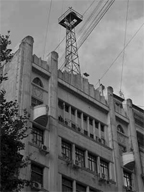
Who owned this building? What was it for?
Why was this architecture implemented?
What did it try to achieve?
What is special about it?
What must be the most distinguished Police Station was once the (now extinct) Diario Crítica headquarters. The newspaper was of tabloid content but very popular. The building is of Art Decó influence, a style in vogue in the 1920’s by Arq. Kalnay.
On Avenida de Mayo 1333, along the year 1926, one of the most extravagant buildings in Buenos Aires: Diario Crítica.
Its owner, Uruguayan editor Natalio Botana, hired Hungarian architects Jorge y Andrés Kalnay.
Av. de Mayo became the domain of many Spanish immigrants and refugees (immigration is thoroughly explained along our 'Best of BA' Walk) During the Spanish civil war, journalists of Diario Crítica who gathered outside this building, were once mistaken for Spanish Republicans by Spanish Falangistas (Gral. Franco's followers) who ferociously beat them up.
(top...)
Palacio Barolo

Who owned this building? What was it built for?
What was strange about the owner?
What is special about the building?
Is it unique?
Who built this building and which other special, unusual buildings did he build?
Palacio Barolo is arguably the most mystical modern building in the whole world.
Entrepreneur and Italian immigrant Luis Barolo commissioned the Italian architect Mario Palanti to design The Palacio Barolo in 1890. Believing that Europe had begun drifting towards a collapse, Luis Barolo intended the building to house the ashes of his hero Dante, away from the disintegrating doom he found in Italy. His partnership with Mario Palanti (also a Dante aficionado) resulted in a safe haven for the soul of Dante in Barolo’s adopted hometown of Buenos Aires.
Luis Barolo and Mario Palanti’s admiration for Dante can be seen throughout the entire structure of the building. The height of one hundred metres corresponds to the one hundred cantos of Dante’s work. The nine access points within the building represent the nine circles and the nine hierarchies of Hell. The still working lighthouse represents the nine angelic choirs. Over the lighthouse is the Southern Cross constellation, aligned with the actual constellation on July 9th, Argentine Independence Day. The care in the detail and reference to the Italian poet is characterised throughout the building right down to the inscriptions in Latin. The overall design structure was also based on the number most prevalent in the Divine Comedy: twenty two. The building’s twenty two floors reflect the number of stanzas in the epic poem, and the building like the work, illustrates the visitors journey through hell, purgatory and paradise as they climb their way to the top. The complex neo-classical façade and tower evoke the expressionist architecture of Spain’s Gaudí whilst also bringing to mind the best examples of Art Nouveau architecture in Paris.
Architect Palanti was a scholar of the Divine Comedy and filled the palace with references to it. The design of the building is based on the golden section and the golden number.
The general building and the Divine Comedy are divided into three parts: Hell, Purgatory and Paradise. The nine access points represent the nine circles and the nine hierarchies of Hell. The lighthouse represents the nine angelic choirs. Over the lighthouse is the Southern Cross constellation, aligned with the axis of the Barolo on the first days of June at 7:45 p.m. The height of 100 meters corresponds to the100 cantos of Dante’s work, with 22 floors, equal to the stanzas of the verses in the Divine Comedy.
The care in detail characterizes the building, from the personal references in Latin to Dante’s work throughout the building, to its inauguration on the poet’s anniversary.
The architect Carlo Hilger details the similarities of the building with Dante’s work, the Divine Comedy.
The distribution of the building is based on the meter of Dante’s Divine Comedy. This is known in architecture as Danteun.
The building is divided into two blocks, with eleven offices per floor in each block. The resulting number, 22, corresponds to the poetic measure used by Dante in the 100 "cantos" (songs). Among the three divisions of the Divine Comedy—Hell, Purgatory, Paradise—that Borges cites in his work “Nine Dantesque essays”, the relationship of the original access by the elevators complies with the Pitagorian number Pi (3.14).
The central hall of the palace has nine arches which represent the nine circles of Hell. This was not theologically based but rather the departure point for the steps required for entering Paradise. The nine arches are divided in the following way: three toward Avenida de Mayo, three toward Hipólito Yrigoyen, the central arch extends to the cupola, and those at the sides containing the stairways.
Each of the six transversal and the two lateral arches contain inscriptions in Latin. Fourteen quotations can be seen pertaining to nine different works, thus maintaining the number that is repeated throughout the Divine Comedy. Some refer to Virgil, others to biblical scriptures. “Words kill, the sprit lives” and “It is built on firm rock” testify to the spiritual feeling with which the building was constructed, determining its character and use: a lay temple that promotes the liberal arts.
On the columns of the transversal arches are four lamps supported by four condors and two dragons, one male and one female, that represent the alchemical principles of mercury and sulfur and their attributes.
The central arch contains a bronze point which originally held the statue of a condor lifting Dante’s body to Paradise. The current owner of this piece is an art collector from Mar del Plata who refuses to sell it to the building’s owners.
The upper floors and the cupola symbolize the seven levels of Purgatory. The cupola is inspired in a Hindu temple dedicated to love and symbolized the union of Dante with his beloved Beatrice.
For those interested in visiting the building inside, we can arrange a guided visit with specialists. Write to us (link above top).
(top...)
Hotel Majestic
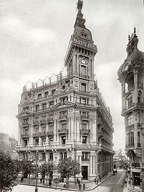
What style are these buildings?
Why was this architecture implemented?
The now extinct Hotel Majestic has now the sad task of housing the Inland Revenue head office when before housed many important guests.
This is followed across the street by the Hotel Chile, an amazing example of Art Nouveau in this city.
(top...)
Monument to Iguazu Falls
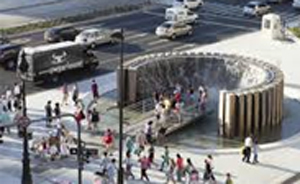
When is this monument most visited?
How does Iguazu compare with other falls?
Which country is it on?
Monument to Iguazu Falls is a semicircle representing the falls' powerful 'Garganta del Diablo' ('Devil's Throat') fall, one of the most famous in this National Park.
Continuosly powered by six pumps, it recycles 100,000 litres of water and hour.
Two additional pumps generate drizzle, imitating the effect visitors fell when visiting the actual falls.
Though it looks smaller, because of its circular shape, the whole monument is 280 metres long and includes a planck to approach the falls (somewhat similar to the --hopefully-- more secure ones at the National Park).
(top...)
Hotel Castelar
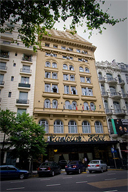
Who built it? Why was he such a special architect?
Who worked and lived here? How did he die?
Hotel Castelar was built in 1928 by famous architect Mario Palanti (Barolo Building, Chrysler Building, and many more) in an Academicist style.
Famous Spanish playwright Federico García Lorca worked and lived here for some time between 1933 y 1934 in room 704 now made into a museum.
He had come to our city for the inauguration of one of his masterworks 'Bodas de Sangre' by actress Lola Membrives at the nearby Teatro Avenida.
Lured back to Spain, he was imprisoned by Gral. Franco's troops and made to day in a most cruel way, both because of Lorca's works ideals and subjects and because he was openly gay --something unacceptablo to dicator Franco's regime.
(top...)
Café Iberia
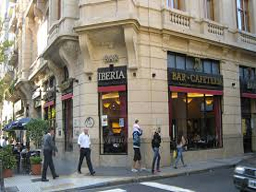
Who used this building?
Who fought in it?
Was this building women-friendly?
Calle 'Esquina de la Hispanidad' ('Hispanic Corner') Café Iberia (ex meeting place for Spanish Republicans) was sited just across Café Español, where Dictator Gral. Franco's followers would gather.
It replaced Café La Armonía (opened 1899) which served the best 'chocolaste con churros' -a Spanish staple- and was also known as the 'Café de Los Cómicos' ('Comedians Cafe') as the actor from the many surrounding theatres would meet there.
Second oldest cafe in town, it was one where families could attend, as in early 1900's it was improper for ladies here to go to cafes.
Here too, the opposing Spanish refugee groups would fight each other violently along Spain's civil war.
(top...)
Bar 36 Billares
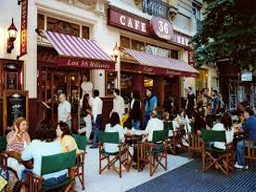
What was this building for initially?
What does it have in the basement?
What can you learn here?
Following the habits in the neighbourhood called 'Puerta del Sol' of the citizens of the Spanish city of Madrid at that time, this was a place where women were offered in prostitution.
Now we find elegant billard-bar '36 Billares', with a flashing red-granite facade and typical canvas awnings.
Here you can find (and join) numerous billiards (and pool) tables, some with grades surrounding them for sitting and watching World-class Billiard championships without missing any subtle detail.
If interested you can join master-classes by local masters.
(top...)
Teatro Avenida
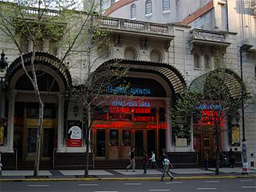
What is this building?
What was it a replacemant for?
From there we can observe the Teatro Avenida. Inagurated in 1908 it was dedicated to Spanish dramaturgy.
Many remarkable authors presented their works here; one of them was Federico García Lorca.
In 1979 the theater caught fire and severe damages happened. It was re-open in 1994, and while the Colon Theatre was closed several years for refurbishing, it served as a surrogate for it, offering many world-class opera representations featuring some of the world's top divas and artists.
(top...)
Monumento al Quixote
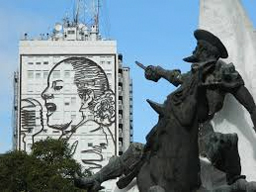
Who was Miguel de Cervantes, and why did he write?
Why is Quixote so famous?
Who is the depicted in the large building wall? Is she eating a hamburger?
Why?
The Monument of Don Quijote de la Mancha is backdropped by Evita's Ministerio de Obras Publicas Mural (we explain ALL about Evita in our Recoleta Walk, where we show her tomb).
Quixote, the inmortal Spanish literature masterwork written by Miguel de Cervantes centuries ago, lived in the territory of 'La Mancha' (the 'stain') a very arid, whitewashed landscape, which is what the white wall in the back represents.
Quixote was a half-crazied old man who decided he would devote the rest of his life to fight evil, so justice and qualify in the eyes of her beloved, idealized lady, Dulcinea.
This monument was inaugurated for the 400 anniversary of the foundation of the city by its sculptor, spaniard Aurelio Teno.
(top...)
Café Tortoni
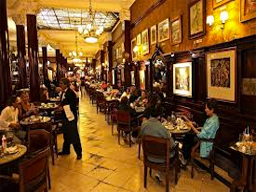
Where was the original entrance?
What did it try to imitate?
Why is it so famous?
Café Tortoni has the Italian name one of its founders chose, imitating French street cafes (though it was the first cafe here to offer streetside seating, this is no longer available).
As the owners and the clients were Spanish, it became special for its Spanish specialties like 'Chocolate con churros' (hot thick chocolate with deep-fried, straightened-out, donut-like pastries).
Café Tortoni was inaugurated in 1858 and relocated here in 1880. Its facade was built by famous versatile super-architect Alejandro Christophersen (lavish Anchorena/San Martin Palace we show in our 'Best of BA' morning walk and also the Russian Orthodox church).
Among its famous regulars you may recognize the names of Albert Einstein, Arthur Rubinstein, Jorge Luis Borges, Carlos Gardel, Juan Manuel Fangio, Federico García Lorca, Benito Quinquela Martín, José Ortega y Gasset and Marcelo Torcuato de Alvear.
(top...)
Florida St.
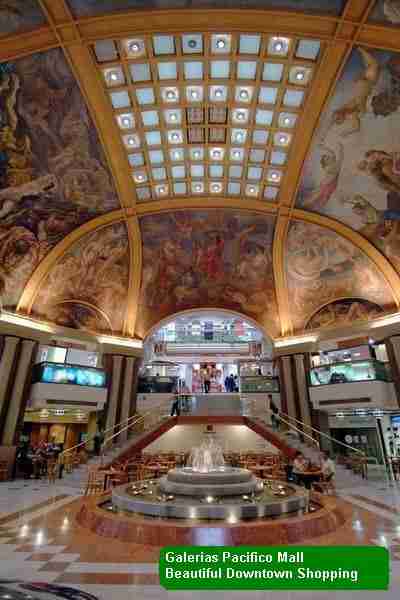
When was it first used?
When did it become pedestrians only?
What events happened on it?
When was it made pedestrian?
What is special about it today?
Florida St. was the old access to one of the old bullfight arena and fort on the Northern side of the old Buenos Aires (extensively explained and shown along our 'Best of BA' morning walk) that later became the Main St.
This was the first street to be paved (with cobblestones) and to be illuminated with lamps.
It was also where victories were celebrated along independence and our national anthem first sung.
(top...)
Edificio La Prensa

Who was this building made for?
What is it today?
Where is the house of this family (with 120 rooms for a famiy of four)?
The magnificent Edificio La Prensa, today Casa de la Cultura, a beautiful example of academicist architecture, Edificio La Prensa & statue on top. Completed in 1898, the Beaux-Arts exterior is notable also for its spire, which is topped by a gilt bronze monument to freedom of the press represented by goddess Pallas Athena (Minerva) weighing 4 tons and who stands 50 m (150 ft) above the ground and holds an electric lamp representing Prometheus' sacred fire of information and on the other hand a newspaper and wassculpted by Maurice Bouval.
The spire also contains a siren, installed in 1900 to symbolically herald news La Prensa considered singular milestones. The siren has been rung five times over the decades: on news of the assassination of Umberto I, the King of Italy, in 1900; on the landing of the Apollo 11 spacecraft on the moon; on the Argentine National Football Team's first FIFA World Cup, in 1978; on the invasion of the Falkland Islands by the last dictatorship, in 1982; and on the return of democracy with the inaugural of President Raúl Alfonsín, in 1983. It became the Ministry of Culture of Buenos Aires. Known since then as the Casa de la Cultura (House of Culture), the building was declared a National Historic Monument in 1995. A passageway built to connect it to the adjacent Buenos Aires City Hall was converted into the Ana Díaz Salon, where art exhibits are hosted.
(top...)
Pasaje Roverano
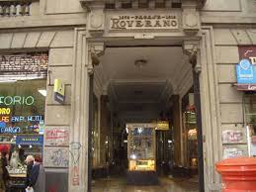
Why would they build this style of venue?
What did it try to imitate?
Elegant Italian-looking 'galeria' was built in 1878 and remodeled by 1918.
As many other Italian like galleries in town it 'perforates' a building thus communicating Av. de Mayo with Hipólito Yrigoyen St.
In this way, citizens could take shortcuts through buildings while being exposed to tempting shop-windows without the worries of carriages, horses, tramways or cars. Pretty cool, eh?
(top...)
Palacio Municipal
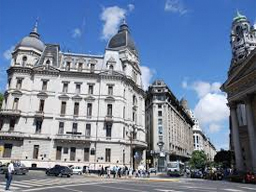
What style is this building?
Whose private bathroom can still be visited here today?
Where is the municipal hall today, and what is on top of it and is quite English?
Starting both avenues, Av. de Mayo and Diagonal Norte, we find the seat of the 'Gobierno Autónomo de la Ciudad de Buenos Aires' (Autonomous Government of the City of Buenos Aires): a mix of Italian academicism and French mansards (roofs).
From the early beginnings, this city would show its embrace of main European influences: French, Italian. Greek, etc. in their vast diversity of implementations and styles.
(top...)
Piccardo, Modern Art Museum & Onassis

Who built this factory building?
What was argentine tobacco like?
What did it become in this building?
Initially built as an industrial British building for a cigarette factory (Oneto's) it is now made and enhanced into a Modern Art Museum (Museo de Arte Moderno de Buenos Aires)
This museum was built using the old 'Oneto Family' Cigarette Factory building.
One of this Cigarette Factory owner (Oneto) good deeds was to stake Aristotle Onassis to a business importing tobacco from the Near East in 1929. Far from the shipping tycoon he would become, Onassis was then a refugee from Turkey selling peanuts on the streets of Buenos Aires. In gratitude, he later gave Oneto a tapestry with the numerals '43' (his own, personally concocted best-selling tobacco mixture for over 50 years) stitched in the center.
In 1923, at the age of seventeen, not-yet shipping magnate Aristotle Onassis who had just arrived in Argentina got his first job as a telephone operator, with the British United River Plate Telephone Company. Overhearing over the switchboard about a good investment opportunity, he borrowed some money which he multiplied fivefold and then went into business for himself with tobacco and made a fortune with it. Mentored by shipping magnate Nicolai Mihanovich (we explain more about this and show beautiful Mihanovich's tower building along our 'Best of BA' morning walk) Onassis eventually relocated to New York where he built up his shipping businesses.
(top...)
Urban Concentration Camps & the 30,000 Dissapeared
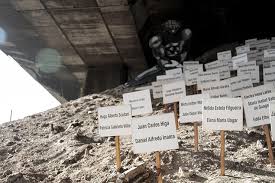
How many times have we had military dictators in Argentina?
When was the most recent one?
Who are the mothers of the Dissappeared? What do they do?
Club Atletico was a former concentration camp for Argentina’s last military dictatorship (1976 – 1983), where people were brought, stripped of their identity, and “disappeared.”
At the end of the dictatorship, the military tried to cover up their past actions by recycling these camps into something nicer (urban highways) but Club Atletico was the only one in Buenos Aires that remained intact from what it was during the 1976-83 dictatorship.
Club Atlético was named this, for it is proximity with the Club Atlético Boca Juniors football club.
(top...)
Lezama Park & National History Museum

What was this area like at this time?
What is it like today?
The mansion was originally built for the American businessman Charles Ridgley Horne in 1846. Allied to the paramount Governor of Buenos Aires, Juan Manuel de Rosas, Ridgley Horne was forced into exile after the strongman's 1852 overthrow, and the land was sold to José Gregorio Lezama. Following his 1894 death, his widow, Ángela Álzaga de Lezama sold the property she had made into a rose-garden to the city, which converted the mansion into the museum, and most of the surrounding land into Lezama Park.
The museum houses over 50,000 items. Portions of the collection were gathered from donations of relatives of important figures in the May Revolution and the wars of independence. Other objects were part of the collection of the Public Museum (Museo Público) created in 1822 by Bernardino Rivadavia.
Its displays include regalia, belongings, furnishings and documents belonging to José de San Martín, María de los Remedios de Escalada, Manuel Belgrano, William Carr Beresford, Juan Manuel de Rosas, Bartolomé Mitre, Juan and Eva Perón, and other Argentine, as well as foreign, statesmen, lawmakers, and military figures who played key roles in the nation's history up to 1950.
(top...)
Pedro de Mendoza's Statue--Earliest Settlement Place
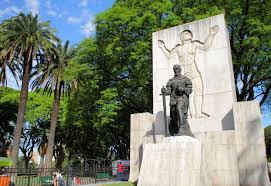
What was built before in this site?
is the aborigine in the back happy or sad? Why?
How many people died here, why and how long did it take?
Pedro de Mendoza, also known as Don Pedro de Mendoza, was from a noble family.
In 1529, he offered to explore South America at his own expense and establish colonies. Thanks to the efforts of his mother María de Mendoza, in 1534 his offer was accepted: he was made adelantado governor, captain general, and chief justice over New Andalusia. This grant allowed him authority over as much land as he could conquer.
The Emperor gave Mendoza 2000 men and 13 ships on the condition that within two years Mendoza should transport 1000 colonists, build roads into the interior, and construct three forts. He was to have half the treasure of the chiefs killed and nine-tenths of the ransom. The office of Governor was also, in theory, made hereditary.
Mendoza founded the first fort in Buenos Aires here on February 3, 1536 but he was not a very effective leader because he always suffered from a very bad case of syphilis. The only chronicler was a German soldier named Ulrich Schmidl. Schmidl came over to the River Plate with Don Pedro and stayed there for eighteen years, fighting in almost every battle. His account of this early history of the River Plate region is the most important document from that time period. You can actually buy the book with his prints on main downtown bookstores.
(top...)
Russian Orthodox Church (donated by the last Czar in 1914)
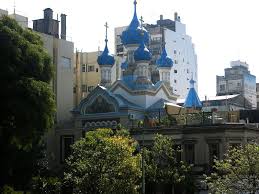
Why were other religion churches built for in an ultra-catholic country?
What did the last Czar donate?
Was this designed by a Russian architect?
The Russian Orthodox Cathedral of the Most Holy Trinity (Spanish: Catedral Ortodoxa Rusa de la Santísima Trinidad) is an Eastern Orthodox church building in Buenos Aires, Argentina. Located in the neighbourhood of San Telmo, it was built between 1898 and 1901, with designs of architect Alejandro Christophersen.
In the mid-19th Century, the first Orthodox Greek and Slavonic immigrants started arriving followed by, a few years later by the Lebanese and the Syrian. They made up a small community who asked and managed to convince Emperor Alexander II to sign a decree for the foundation in Buenos Aires of an Orthodox Church attached to the Russian Empire’s Legation in South America.
The church was designed by the architect of Rusia Mihail Preobrazensky Saint Synod in St. Petersburg and the work was directed in Argentina by the artist Cristophersen opening in 1904. The style is byzantine, moscow’s 17th Century with fives onion-like domes on the facade, turquoise colorful topped by five crosses overlooking the East, with stars symbolizing the celestial sphere.
(top...)
James Brittain's 'toll road' to La Boca
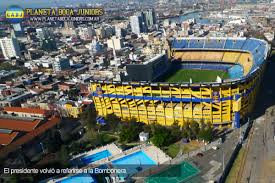
How do you reach La Boca?
Who built this road?
What was the role of the British in our economy?
James Britten was an English navy officer, who came here during the British invasions of 1807. Loving it here, he married a local English girl and saw opportunity in buying ships and building roads.
In 1817 he bought a whole convent (!!) from the prior of the 'Convento de los Predicadores' fray José Ignacio Grela, a huge parcel on the Boca del Riachuelo (river's mouth).
His land occuoied all th land from Lezama to La Boca and included the house called Yellow House you can still see today.
He also sarted cultivating a new kind of pears, now internationally sold and known as Peras Williams ('William's pears').
In 1821 he convinced the governement (he was a friend of tyrant Rosas) to alloow him to charge a toll if he paved the marshy land he owned between Parque Lezama and La Boca and did it. Today it is the avenue that leads to La boca and it is name after his friend Almirante Brown, the irishman who gounded our Navy--we explain all about him on our Recoleta cemetery walk as e is buried there. Brittain also built the aforementioned Yellow House which later became the house of Admiral Brown.
Brittain, a rich man, lived instead in what used to be the house of Martín de Sarratea, the richest man in Argentina and brother in law of the Vicerroy, later buying for himself an even better land at what is today Plaza Rodríguez Peña (where the National Education Board Palace stands today).
He later imported printing machines which were sold to the governement and became part of of the board of Directors of the Bank of Buenos Aires. Together with his fgellow Englishmen Armstrong, Robertson & Fair they held over 83,5% of the banks shares and control.
(top...)
La Boca & Caminito
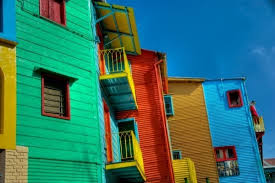
Why is this so colorful?
What is the story of its benefactor and who was he?
What is this area's contribution to the rest of the world?
La Boca is a neighborhood, or barrio of the Argentine capital, Buenos Aires. It retains a strong European flavour, with many of its early settlers being from the Italian city of Genoa. In fact the name has a strong assonance with the Genoese neighborhood of Boccadasse (or Bocadaze in Genoese dialect), and some people believe that the Buenos Aires barrio was indeed named after it. The conventional explanation is that the neighborhood sits at the mouth (boca in Spanish) of the Riachuelo.
In 1882, after a lengthy general strike, La Boca seceded from Argentina, and the rebels raised the Genoese flag, which was immediately torn down personally by then President Julio Argentino Roca.
Among sports fans, Boca is best known for being the home of world renowned football club Boca Juniors. The club plays their home matches in the Estadio Alberto J. Armando, popularly known as La Bombonera (The chocolate box in Spanish)
During the 1800s, a small stream flowing into the Riachuelo River ran along the same route where the Caminito is now. Later that century, this area of the stream became known as the Puntin, the Genoese diminutive term for bridge (a small bridge allowed people to cross the stream there). When the stream dried up, tracks for the Ferrocarril Buenos Aires y Puerto de la Ensenada were installed at the site. Disused tracks remain at the end of Caminito, along Garibaldi Street.
In 1954, the railroad closed, and the area where Caminito was became a landfill and the neighborhood's eyesore. Over the following three years, Argentine artist Benito Quinquela Martín who lived nearby, painstakingly prepared the walls facing the abandoned street, applying pastel colors, and by 1960 had a stage put up at the southern end; the wooden-plank stage was replaced with a nearby theatre house in 1972. The artist was a personal friend of Argentine tango composer Juan de Dios Filiberto, who created a well-known 1926 tune by the same name.
(top...)
Buenos-Aires-Walking-Tours.com
Reservations (Whatsapp enabled) in English, click on number below:
Tel. +(54 911) 6566-5050
|
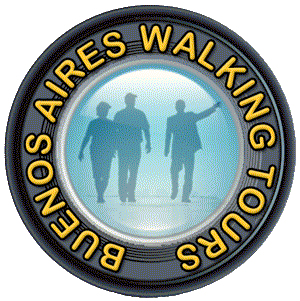


![]() Some key sights:
Some key sights:

















































